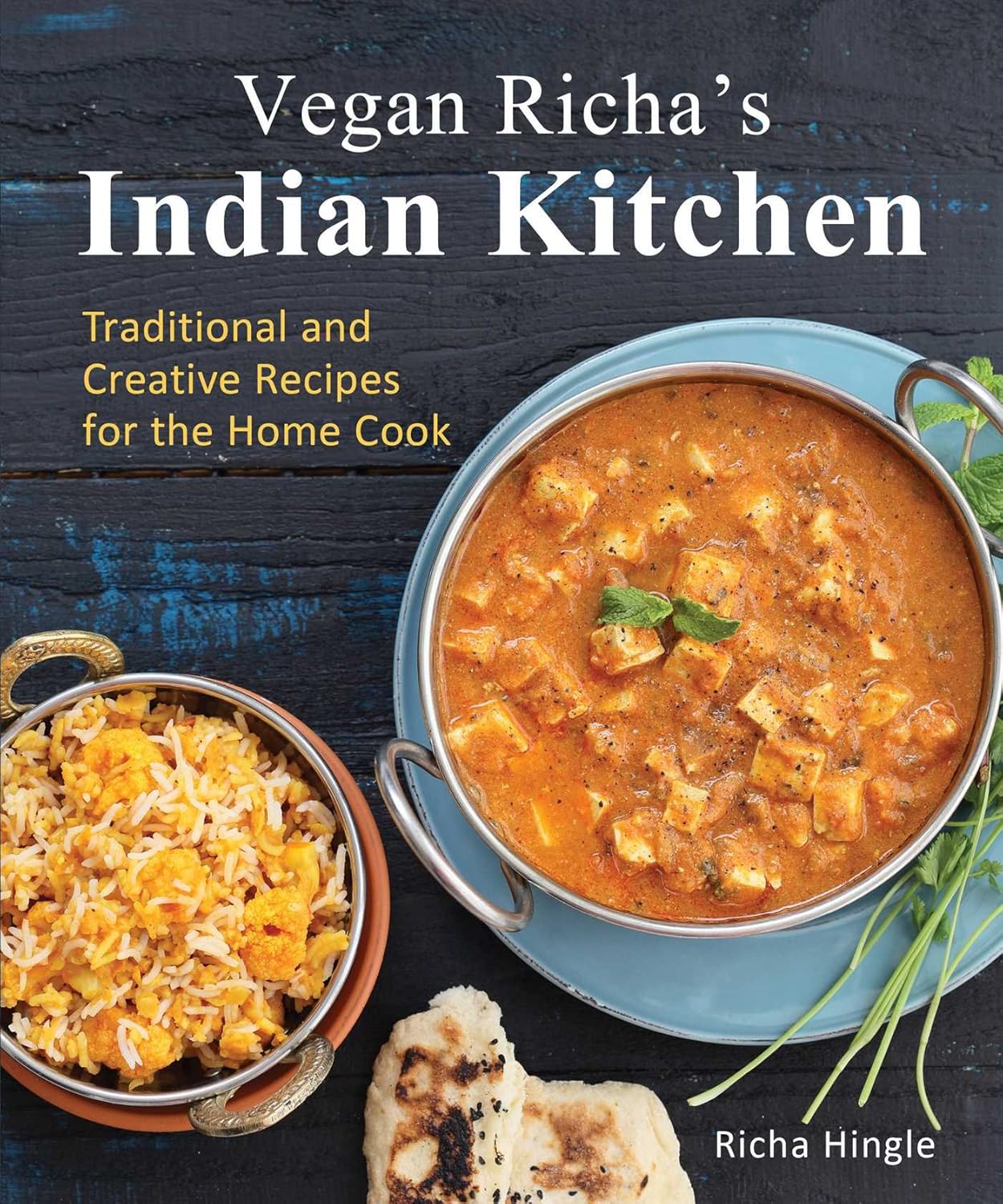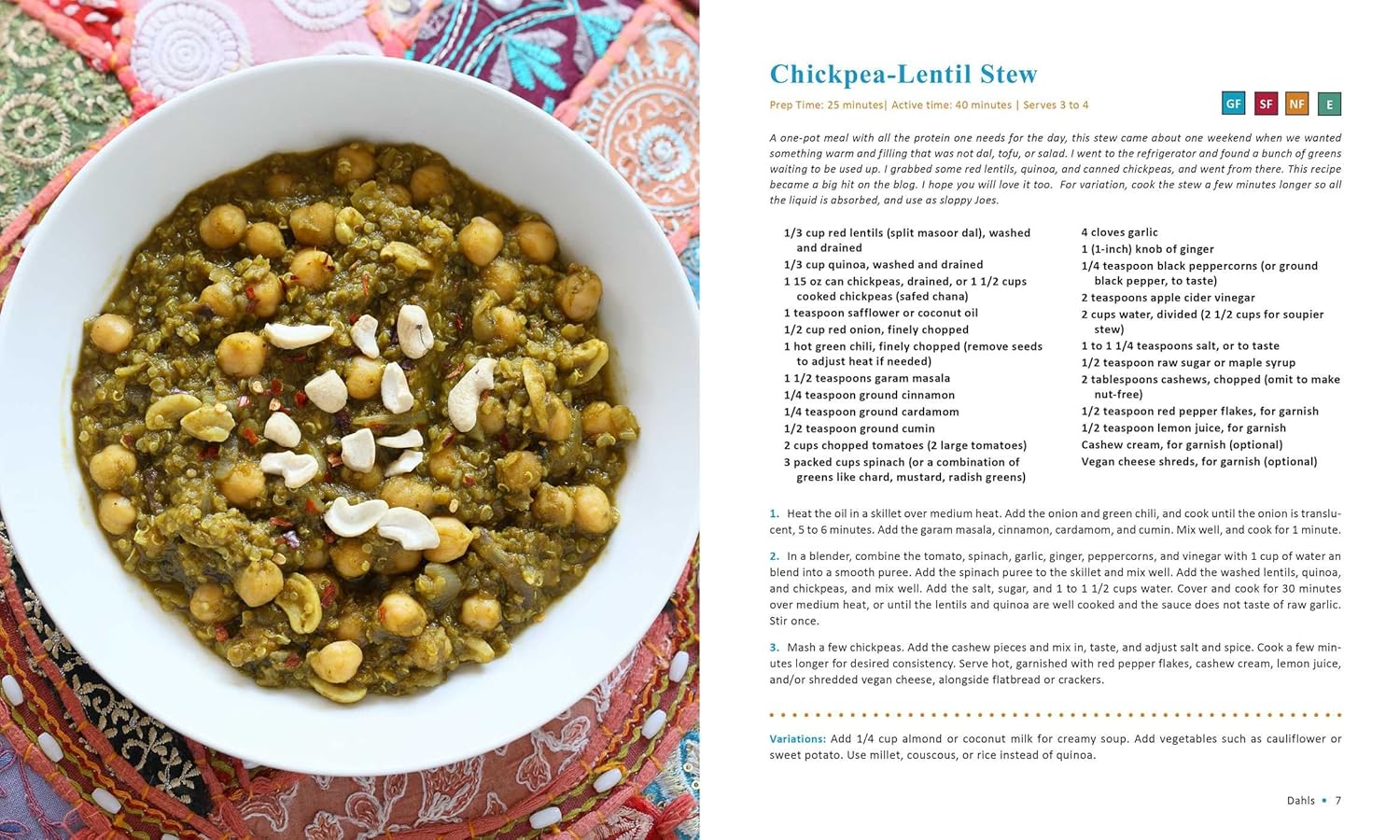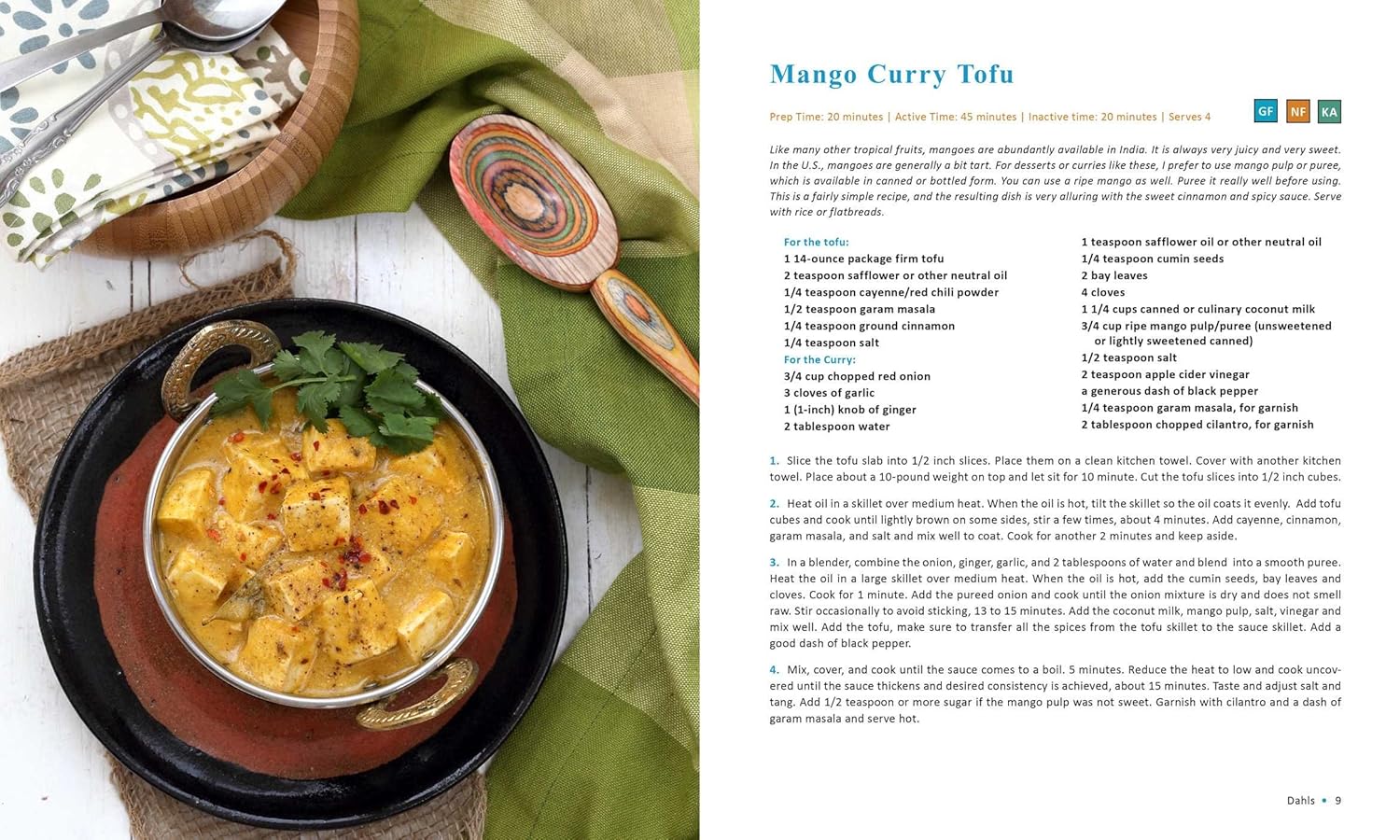4.5
Customers say
Customers find the recipes delicious and authentic with rich flavors. They find the book easy to follow and prepare, with simple instructions and options for substitutions. The recipes are healthy and plant-based, appealing to both vegans and meat eaters alike. The pictures are beautiful and well-received. Readers appreciate the helpful explanations about spices and techniques used in Indian cuisine, as well as the author’s personal notes about each dish. Overall, customers find this a useful reference and practical guide for Indian cooking.
AI-generated from the text of customer reviews
The ultimate plant-based Indian cookbook by the creator of VeganRicha.com.
From delicious dals to rich curries, flat breads, savory breakfasts, snacks, desserts and much more, this book brings you Richa Hingle’s collection of plant-based Indian recipes inspired by regional cuisines, Indian culture, and local foods. Who would have thought you could one day enjoy dairy-free rasmalai, sandesh, or gulab jamun.
Whether you want to enjoy Indian cooking, try some new spices, or add more protein to your meals using legumes and lentils, this book has got it covered. You’ll explore some well-known and new Indian flavors that are easy to make in your own kitchen. Learn the secrets of eclectic Indian taste and textures, and discover meals in which pulses and vegetables are the stars of the dish. And once you taste Richa’s mouth-watering desserts, they will likely become your new favorites.
Within these pages you will find recipes to please all the senses, including:
Mango Curry TofuWhole Roasted Cauliflower in Makhani Gravy – Gobi MusallamStreet Style Tempeh Wraps – Kathi RollsQuick Tamarind-Date ChutneyAvocado NaanFudgy Cardamom Squares – BurfiThe recipes have been designed to simplify complex procedures, and Richa’s workflow tips incorporate modern appliances and techniques from other cuisines to reduce cooking times. Replacement spices are indicated wherever possible, and Richa also provides alternatives and variations that allow people to be playful and creative with the spices called for in the recipes. The recipes are allergy friendly and many are or have gluten free and soy free options
The restaurant-quality recipes are ideal to make for yourself, for family, and for entertaining guests.Sidebars.Tips.Index.Full-color photos.
From the Publisher


Mom’s Okra and Onion Stir-Fry (Pyaaz Waali Bhindi)
Prep: 10 minutes | Active: 15 minutes | Inactive: 45 minutes |Serves 4
Either you like okra or you hate it. This recipe might help you like it. Okra is cooked with onions until crisp and no hint of slime remains. This is another one of Mom’s simple recipes. She cooks the okra, spiced with just cayenne and turmeric, on low heat for an hour so it is perfectly crisped. Serve this easy and delicious stir-fry with any of the spicy dals or spicy curries. (Shown in thali photo, page 19, at top right.)
Heat the oil in a large skillet over medium heat. Add the green chile and cook for 2 minutes. Add the onion and cook until translucent, 6 to 8 minutes. Reduce the heat to medium-low.Add the okra and turmeric, mix well, and cook uncovered for 35 to 45 minutes, stirring twice while cooking.Once the okra is cooked to your preference, add salt and cayenne. Mix well and cook for 1 minute. Remove from heat. Serve hot. Variations:
Add 1/2 teaspoon cumin seeds or fennel seeds with the green chile at Step 1.Add 1/2 teaspoon dry mango powder or 1/4 teaspoon Indian black salt at the end and mix well.Add 1/2 teaspoon garam masala along with the salt.
2 teaspoons safflower or other neutral oil 1 to 2 hot green chiles, finely chopped (remove seeds to reduce heat) 1 1/2 cups chopped or thinly sliced red onion 3 cups chopped fresh okra 1/4 teaspoon turmeric 3/4 teaspoon salt 1/2 teaspoon cayenne

Street-Style Tempeh Wrap

Butternut Coconut Red Lentil Curry

Sweet and Spicy Baked Cauliflower
Add to Cart
Customer Reviews
4.8 out of 5 stars 1,027
Price
$15.36$15.36
More from Richa Hingle:
Publisher : Vegan Heritage Press, LLC; Illustrated edition (May 19, 2015)
Language : English
Paperback : 256 pages
ISBN-10 : 1941252095
ISBN-13 : 978-1941252093
Item Weight : 2.31 pounds
Dimensions : 7.4 x 0.7 x 9 inches















Cheesenerd –
Without a doubt- one of my favorite cookbooks (Indian or not)
I will first preface this by saying that I am not a vegan, I am a lacto-ovo vegetarian of over 15 years. I am a big fan of Indian cuisine and bought this book looking for another good Indian vegetarian cookbook to add to my repertoire. This one very quickly became my favorite to date. I bought this book back in April of this year (It is now July- same year) and have made probably about 10 recipes out of it- a couple I have made multiple times and had an opportunity to get better at some of the more complicated ones.I’ll start with the overall look of the book itself. The size of the book is very practical- not huge like some of my cookbooks but large enough enough to make the pictures and text very easy to read and interpret. I do not believe that every single recipe has an associated photo but many of them do and they definitely inspire you to cook.Organization is very important with any cookbook- from the standpoint of technique, I think this is where this book really shines. Most “ethnic” cookbooks start with an introductory section that covers the basic ingredients- particularly those that may be a little more unusual to their target audience. Richa takes this a step further, this section is chapter 1- she breaks it up into sections and gives an overview of what each ingredient is and what it actually contributes to the cuisine. I also appreciate that she gives both the English names and the Hindi for the various ingredients. This is very helpful when shopping for two reasons:1) Some of the ingredients given do not actually have a meaningful English name that are widely used2) Some of the ingredients do have an English name- but it is shared with something more common here (e.g. There is both a “Bay Leaf” common in the US, and a “Bay Leaf” used in Indian cuisine- tejpatta which is more closely related to Cinnamon than to Sweet Bay common in the US)The last thing I will say about this section is that she tops it off with a shopping list of Indian ingredients broken down into “Must Have” ingredients, “Good to Have” ingredients, and “Nice to Have” ingredients. I found this incredibly helpful when I started because I was able to go online to an Indian grocer and simply add one of everything from the “Must Have” and one of each of the harder to find locally items from the “Good to Have” list. I spent less than $100 and don’t anticipate needing to buy Indian spices for a long time.Now for the recipes. The first thing I will say is that this is not the best cookbook to buy if you are looking for recipes which are quick and easy- done in 30 minutes. This is a book you buy if you are looking for quality and an authentic flavor. The biggest thing I appreciate about this book is the apparent commitment to authentic ingredients. Richa seems unapologetic about the relative obscureness of some of the ingredients and I like that (and really she should be unapologetic- this is the 21st century, everything in her book can be found online or at an Indian Market if you live close to one). For those without a local Indian market, she does provide some links to online grocers. She does provide suggestions for substitutions with regard to some of the ingredients but I have not found it necessary to use them.The books contains a lot of the classics (Vegan styled) you would expect to see at your favorite Indian restaurant (Particularly one which draws from Punjabi cuisine)- Palak Tofu (Palak Paneer), Chana Masala, “Dad’s Favorite Cauliflower Potatoes” (Gobi Aloo), Tempeh Tikka Masala (A veganized version of Chicken Tikka Masala). Additionally, she adds in a few recipes which seem to demonstrate her creative side a little more (e.g. Avocado Naan).I found the recipes to have a lot of depth and complexity to them. They do take a considerable amount more time than I think some people might be used to putting into a recipe; however, if you prep your ingredients ahead of time it really makes your life much much simpler in this respect (Most of the recipes I have worked with to date have over 20 ingredients each- most of which are spices of some kind). Many of the recipes take longer but most of this it time spent simmering or boiling down rather than attention demanding time. Again, prepping ahead of time really makes a huge difference.The only negative I can think of is that some of the recipes were not clear on some points (or I missed a detail somewhere) such as when to boil with the lid on and when to do so with the lid off. Sometimes she specifies this and sometimes I think she assumes it is clear from context. Given how much time is spent boiling things down this distinction is pretty important but I did find as time went on and I got used to the recipes I found myself reading between the lines and sort of intuitively knowing what to do. My best advice is when in doubt- either try to find the recipes on her website or find a similar recipe elsewhere and see what they do. I also found that some of the recipes seemed to call for too little water or other liquid- admittedly this may have been my misinterpretation of technique. There have been recipes which I questioned but tried out and had great results.Overall, if you are looking for something leaning in the authentic flavor direction and plant based then you can’t go wrong with this book. My recommendations based on the recipes I have worked through so far-1) Start on the low end with salt and add to flavor toward the end. Many of these dishes can become overly salty pretty easily. This is especially true with the black salt which adds a wonderful flavor to dishes like Channa Masala but if you add too much can quickly make your dish taste “eggy”.2) Man of these dishes can burn very very easily if you are not careful. It will take a little getting used to but when you are cooking down be sure to keep an eye on things and deglaze with water before you get to the burning point if needed- I found that my cooking times often varied from what the book stated.3) Definitely read the entire recipe ahead of time and make sure you understand each step. It is also very much worth your time to read chapter 1 before you make a single recipe (18 pages- many of which are charts or pictures)4) I like to prep my ingredients ahead of time according to step. I put all of my step 1 spices into a cup, step 2 spices and vegetables, etc… that way when the time comes I just have to pour them into the pot.5) These techniques take practice. I would suggest not trying a new recipe on guests. Make it a time or two for yourself and see how it goes first. Many of my first attempts ended up in the trash (Gobi Aloo being a good example- first try was a smoking disaster).Happy Cooking!
Amazon Customer –
Buy this cookbook now!
I promised myself that I was NOT going to buy this book. I already own hundreds of vegetarian and vegan cookbooks and the last thing I needed was another cookbook. However, I really like the Vegan Richa blog and once I could virtually “look inside” the book, I realized that the majority of recipes appealed to me. I received the book a week ago. Here are the recipes I’ve tried so far: Spicy South Indian Tofu Scramble, Street Style Tempeh Wraps, Mint Cilantro Chile Chutney, Mashed Potato Fritters (baked), Dad’s Favorite Cauliflower Potatoes, Tofu in Spinach Curry, and South Indian Chickpea Eggplant Stew. Every recipe was amazing and my husband and I were so impressed with how well the Mashed Potato Fritters turned out. The book is perfect in every way. The recipes are clear, concise, and well organized. The photographs are appetizing and inspiring. Richa gives preparation choices, always allowing you to make recipes low fat and healthy. The flavors are just fabulous. I’ve owned other vegetarian Indian cookbooks before, but have usually found that the recipes are excessively complicated or just too high fat. I did visit a local Indian grocery store and stock up on recommended spices and ingredients, a small investment that has already paid great dividends! These foods are even better than Indian restaurant foods because they are not heavy, loaded with greasy coconut milk, or fried.My only problem with this book is that I have to force myself to use my other cookbooks sometimes.Update: I have had this book for many months now and I’ve come to the conclusion that this book needs it’s own category: cooking magic! The recipes are superb. I have not been disappointed in anything that I have made. An added bonus is that my house smells heavenly whenever I make any of these recipes. Recommended without hesitation.
Paul Massieu Arvizu –
I love the book. Used to cook with it until I gave it away. The book arrived in excellent condition.
Judith –
The recipes are well written and easy to follow. Lovely photos, too. Ingredients needed are easy to find. I had nearly all in my kitchen. Eating vegan will never be boring if you have this book. Lots of variety! Fantastic flavours!
EsBo –
Good recipes, requires a lot of Indian spices and after a while, a lot of them tastes similar
No-Shoes-the-Fish –
This book is incredible – simple to use, easy to follow and the meals I’ve made so far, were delicious (Tofu Mango Curry, couple of dals, rotis). Yes, there isn’t photos for every dish, but it doesn’t matter – you can trust the recipes and just go with them. Lots of swap-outs for GF, or soy-free options. The avocado naans look divine, they will be next on the list…Depending on your confidence as a cook, there may be some spices/ingredients you’re less familiar with (tempeh, certain spices)…my top tip? Take a trip to your local Indian supermarket – I went to mine and for £40, I got literally EVERYTHING I’ll ever need (and this book tells you at the beginning, what cupboard staples etc to get). In fairness, at least £15 of that was Indian snacks I bought because I like them, not anything needed for these recipes.I cook a fair bit, but am by no means and expert, and this book is superb. Buy it, stock up, amaze your friends, neighbours, pets, random stranger you’ve met at a bus-stop or Indian Supermarket with your fine foods.
Fabíola Ferr –
Finalmente posso fazer minha própria comida indiana sem tanta pimenta… Receitas incríveis.